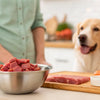How to Start Your Dog on a Raw Food Diet: A Comprehensive Guide for Pet Owners
- Houndsy
Table of Contents
- Introduction
- What Is a Raw Food Diet for Dogs?
- Benefits of Raw Feeding
- Concerns About Raw Feeding
- Step-by-Step Guide to Transitioning Your Dog to a Raw Food Diet
- Essential Nutritional Components for a Raw Dog Diet
- Conclusion
- FAQs about Raw Food Diets
Introduction
Do you ever wonder about the food your dog eats? Recent studies show that many commercial dog foods can often be loaded with fillers, additives, and synthetic ingredients that may not be ideal for our furry friends. As devoted pet owners, we often seek ways to provide our dogs with the best nutrition, aligning their diets with their biological needs. Transitioning to a raw food diet might be the answer you've been searching for.
In this blog post, we will explore how to start your dog on a raw food diet, addressing the various benefits, potential concerns, and practical steps involved in making the switch. You will come away not only with a deeper understanding of what a raw food diet entails, but also with a clear roadmap to safely introduce this new way of eating into your dog's life.
We understand that making dietary changes can be daunting. That’s why we’ll provide a practical, step-by-step approach that takes into account your dog's individual needs. You'll also learn about the qualities you should look for in raw dog food products, along with tips on how to manage the transition. So, let's embark on this journey to revolutionize the way we feed our canine companions!
What Is a Raw Food Diet for Dogs?
A raw food diet, often referred to as a “biologically appropriate raw food” (BARF) diet, consists primarily of uncooked and unprocessed ingredients that closely resemble what dogs would eat in the wild. This type of diet typically includes:
- Raw Meat: Such as beef, chicken, turkey, lamb, fish, or organ meats.
- Bones: Raw, meaty bones provide essential minerals and help maintain dental health.
- Fruits and Vegetables: While dogs are primarily carnivores, they can benefit from certain fruits and veggies, which can add vital nutrients.
- Supplements: Some raw feeders choose to add supplements to ensure nutritional balance.
The goal is to mimic the natural diet of our canine companions' ancestors, which can support their overall health, digestion, and vitality.
Benefits of Raw Feeding
Before we dive into the steps of transitioning to a raw food diet, let’s explore some of the benefits that come along with this dietary shift:
1. Improved Digestive Health
Many dog owners report that their pets experience firmer stools, reduced gas, and overall better digestion after switching to a raw diet. Raw food is easier for dogs to digest than many processed kibbles, allowing them to absorb nutrients more efficiently.
2. Enhanced Coat Quality
Feeding your dog a raw diet rich in omega-3 and omega-6 fatty acids can lead to shinier and healthier skin and coat. The natural oils found in fresh meats and fish often improve coat quality, minimizing itchiness and dryness.
3. Increased Energy and Vitality
A diet rich in high-quality proteins provides dogs with necessary energy. Many owners notice their pets have more stamina and overall vitality after making the switch, which is especially beneficial for active dogs and puppies.
4. Weight Management
Raw feeding can help maintain a healthy weight in dogs due to the appropriate ratios of protein and fats. Many pet owners have reported that their dogs are able to maintain a healthy weight more easily on a raw food diet.
5. Reduced Allergies
Some dogs with food sensitivities experience relief from symptoms such as itching or gastrointestinal issues when they start a raw diet. Raw feeding allows you to control the ingredients and avoid potential allergens.
Concerns About Raw Feeding
While there are many benefits to raw feeding, it’s important to also consider some of the challenges and potential risks:
1. Nutritional Balance
One of the main concerns is ensuring the diet is nutritionally balanced. A poorly planned raw diet can lead to deficiencies or imbalances.
2. Safety Risks
Raw meats can carry harmful bacteria like Salmonella or E. coli, which can affect both dogs and humans. Proper handling and sourcing of ingredients are essential.
3. Cost
Raw feeding can be more expensive than traditional kibble, particularly if you are sourcing high-quality, organic ingredients.
4. Preparation and Convenience
Raw feeding often takes more time and effort than simply pouring kibble into a bowl. It requires preparation and planning to ensure each meal meets your dog’s dietary needs.
Step-by-Step Guide to Transitioning Your Dog to a Raw Food Diet
Now that we've established a solid understanding of what raw feeding entails, let's discuss how to start your dog on a raw food diet. Here’s a comprehensive step-by-step guide:
Step 1: Consult with Your Veterinarian
Before making any dietary changes, it is important to consult with a veterinarian who supports raw feeding. They can provide guidance based on your dog's unique health needs and help you understand any specific requirements for transitioning.
Step 2: Research and Planning
Gather information about raw feeding and familiarize yourself with the various types of meats, bones, fruits, and vegetables that are safe for dogs. Consider the benefits of our flagship product, the Houndsy Kibble Dispenser, which can also be used for portion control once you transition to dry food as well.
Step 3: Choose Your Raw Food Sources
You can either prepare a home-cooked raw diet or purchase commercially prepared raw dog foods. If going the homemade route, ensure your recipes provide balanced nutrition. If choosing commercial options, look for brands committed to high-quality, natural ingredients.
Step 4: Gradual Transition
Transitioning to a raw food diet should not be rushed. A sudden switch can upset your dog's digestion. Instead, gradually introduce raw food to their meals over 7 to 10 days using one of the following methods:
A. Cold Turkey
Some pet owners prefer to switch directly to raw food overnight. This method works well for dogs with robust stomachs but can lead to digestive upset for others.
B. Mixed Transition
Often the preferred method, this involves mixing the old kibble with raw food:
- Days 1-3: 75% old food, 25% raw food.
- Days 4-6: 50% old food, 50% raw food.
- Days 7-9: 25% old food, 75% raw food.
- Day 10: 100% raw food.
C. Gradual Switch with Treats
Start introducing raw food as a treat and monitor your dog for any digestive issues before fully integrating it into their meals.
Step 5: Monitor Your Dog
Once your dog is on the raw diet, keep an eye on their health and well-being. Watch for changes in energy levels, coat condition, and stool quality. If you notice any concerns, consult your veterinarian.
Step 6: Adjust and Optimize
Every dog is different. Be ready to make adjustments to your dog’s diet based on their preferences and health. Introduce variety into the diet, including different protein sources and supplementing with fruits and legumes.
Step 7: Educate Yourself
Stay informed about raw feeding best practices, recipes, and nutritional guidelines. Join communities or online forums where you can learn from experienced raw feeders.
Essential Nutritional Components for a Raw Dog Diet
When planning a raw diet, it is vital to ensure it includes adequate quantities of the following nutritional components:
1. Protiens
High-quality proteins should make up the majority of your dog's raw diet. They should come primarily from animal sources, such as:
- Lean meats (beef, chicken, turkey)
- Organ meats (liver, kidneys)
- Fish (salmon, sardines)
2. Bones
Raw bones provide essential minerals like calcium and phosphorus. Include meaty bones in your dog's diet to help maintain healthy teeth while also incorporating minerals.
3. Fruits and Vegetables
While not as essential, including small amounts of fruits and vegetables can provide additional vitamins and phytonutrients. Examples include:
- Carrots
- Blueberries
- Spinach
4. Supplements
You may consider adding supplements to ensure your dog receives all necessary vitamins and minerals. Consult with your veterinarian on the right options, which could include fish oil for omega fatty acids or specific multivitamins for dogs.
Conclusion
Transitioning your dog to a raw food diet can be a rewarding experience that enhances their health and well-being. By taking the time to educate yourself, consult with your veterinarian, and follow a structured transition plan, you can make this dietary change successfully.
At Houndsy, our mission is to simplify pet care while enhancing the quality of life for our furry friends. Our products reflect our commitment to design excellence and functionality, including our Houndsy Kibble Dispenser, which complements any feeding style and helps to provide consistent portions.
FAQs about Raw Food Diets
1. Is a raw food diet safe for my dog? Yes, a raw food diet can be safe for dogs if handled properly. Always ensure meats are sourced from reputable suppliers and practice safe food handling.
2. How much raw food should I feed my dog? The amount varies based on your dog's size, age, activity level, and health. Generally, you can feed dogs 2-3% of their body weight in raw food per day.
3. Can all dogs switch to a raw food diet? Most healthy dogs can benefit from a raw food diet. However, dogs with certain health conditions should consult their veterinarian for tailored advice.
4. How long will my dog take to adjust to a raw food diet? Most dogs will take a few days to a couple of weeks to adjust. Implementing a gradual transition helps minimize digestive upset.
5. What if my dog doesn't like raw food? Some dogs are picky eaters. Gradually introducing raw food while mixing it with their preferred kibble or using it as treats can help encourage them to accept the new diet.
Considering these questions and answers can ease your transition to feeding raw and establish a nutritionally sound plan for your furry friend. With the right approach, we can ensure that your dog enjoys the benefits of a natural, unprocessed diet moving forward!













